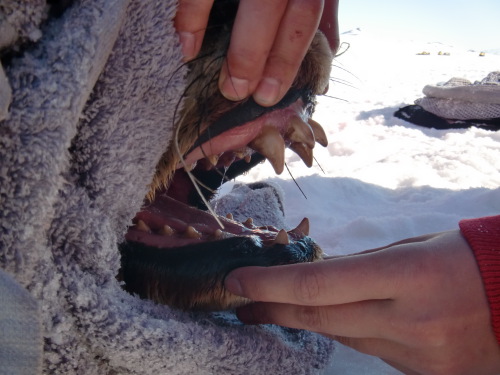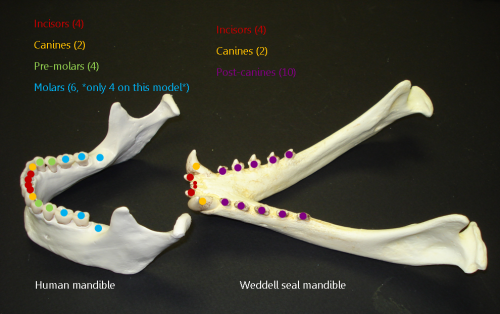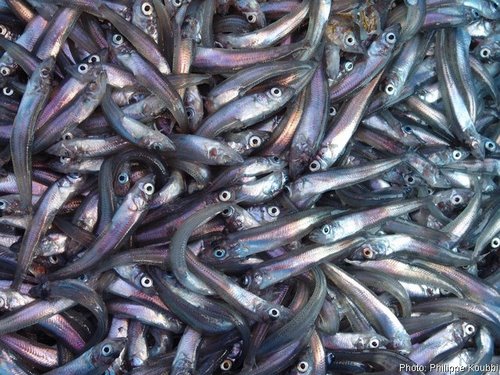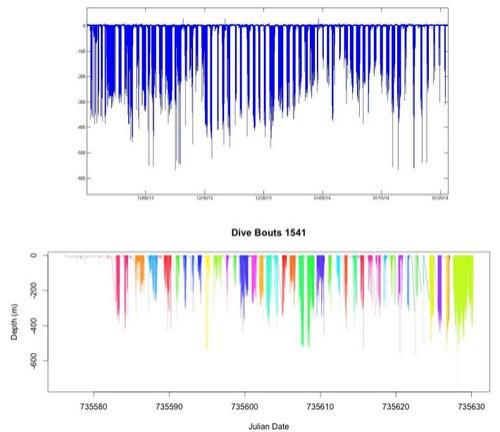A Weddell Seal’s Teeth!
This journal is brought to you by…
 This journal is brought to you by…
This journal is brought to you by…
- Ms. Allen and Ms. Richards 3rd grade classes at Germantown Elementary
- Ms. Tony’s 7th grade class at St. Philomena School in Illinois
Crosswind Elementary Students:
Hadyn Gross in 2nd grade
- Simone Nguyen in Kindergarten
Open wide! Let’s take a look inside the mouth of a Weddell seal!
 Take a look at the Weddell seal’s teeth. Photo credit: Alex Eilers.
Take a look at the Weddell seal’s teeth. Photo credit: Alex Eilers.
Look at those teeth! Yikes!
You can definitely tell that seals are carnivores by looking at their teeth! Carnivores are animals that eat meat (mostly fish, in this case), and their canines help them to do that. Canines are the long, sharp, pointed teeth. They are used to quickly grab prey and firmly hold it.
Weddell seals have 4 canine teeth – two on top and two on bottom.
Between the canines are their incisors – 4 on top and 4 on bottom. Do you see how much larger the outer two incisors are, compared to the 2 in the middle (both on top and bottom)? Weddell seals have a special use for these teeth.
 Weddell seal’s teeth showing both the canines and incisors. Photo credit: Alex Eilers.
Weddell seal’s teeth showing both the canines and incisors. Photo credit: Alex Eilers.
Both the canines and the incisors stick out quite a bit! Do you know why that is?
Weddell seals live further south than any other seal. The Weddell seals that we are studying live under the sea ice in the Ross Sea. But how do they get above the ice to breathe?
With the help of their teeth! Their canines and incisors are specially adapted to help – they stick out! This adaptation allows them to ream or break through the ice to keep their breathing hole open.
Check out this video to see how they do it!
Did you notice how far the seal opened its mouth to ream the ice? Just like our jaw, the top part is stationary while the lower part, or mandible, moves up and down. The Weddell seal can open its jaw very wide, which makes it easy to ream an ice hole or open wide to catch a foot-long fish!
With all that reaming, it’s no wonder their teeth show some wear and tear as they get older!
Back teeth – post-canines
In the back of our mouths we have premolars and molars. We use them to grind food after we’ve taken a bite. But check out the Weddell seal’s back teeth. They have what are called post-canine teeth. If you have a mirror, take a look at your molars and compare them to the picture of the Weddell’s post-canine teeth.
Our molars have a broad, rectangular shape and are basically flat on top with a slight dip in the center. They are specially adapted to grind food.
The post-canine teeth of a Weddell have a small, oval base which peaks to a rounded point. Do you think these teeth are used for grinding food, or do they have another purpose?
If you said no, you are correct! Since Weddell seals typically swallow their food whole, they don’t use post-canines for grinding food. Their teeth are used to help get the food down.
 What differences do you notice between these teeth? Photo credit: Alex Eilers.
What differences do you notice between these teeth? Photo credit: Alex Eilers.
Weddell seal teeth vs. Leopard seal teeth
We’ve talked a little bit about some of the predators of the Weddell seal. One of those predators is the Leopard seal. It is true that a Leopard seal would love to eat a tasty Weddell for lunch, but it rarely gets the chance. Do you know why? Check out the picture below.
 See any difference between the leopard seal’s teeth (left) and the Weddell seal’s teeth (right)?
See any difference between the leopard seal’s teeth (left) and the Weddell seal’s teeth (right)?
Photo credit left: australiangeographic.com Photo credit right: ameliorator.blogspot.com
Notice the worn-down teeth on the skull of the Weddell seal (right). Now, look at the teeth of the Leopard seal (left). Do they look like they’ve ever reamed ice? No way – they are still sharp! They also point downward instead of pointing out like a Weddell seal’s teeth. Leopard seals can’t ream ice. This means they can’t live as far away from open water as a Weddell seal can!
What’s on the menu?
This time out on the ice, we are very interested in the diet of the Weddell seal. For example, which do they like to eat more, Antarctic cod or silverfish? Both fish live at similar depths of the ocean, but they have one big difference – their size!
 Take a look at these Antarctic Silverfish. Credit: Philippe Koubbi.
Take a look at these Antarctic Silverfish. Credit: Philippe Koubbi.
 And these Antarctic cod. Credit: Peter M. Amati.
And these Antarctic cod. Credit: Peter M. Amati.
Antarctic cod can weigh up to 150 pounds! That’s one big fish! Weddell seals eat most of their food underwater and swallow them whole, but it’s difficult to eat something as big as an Antarctic cod fish underwater! So they have to bring it to the surface and tear it apart with those big incisors and canines! This takes a lot more energy than eating silverfish.
Why is this important to our study?
Weddell seals dive in bouts, meaning they dive over and over again and then will stop for a while, either to rest or because they aren’t hungry anymore. Our research team is interested in the length of each dive during a bout, especially the last dive of the bout. This can tell us a lot about what a seal is eating. If the last dive is much shorter than the other dives in the bout, then the seal probably grabbed a nice, tasty Antarctic cod to enjoy at the surface! If the length of time is the same, the seal probably filled up by eating silverfish underwater.
Check out the graphs below. They are both records of a Weddell seal’s diving, but the second graph has been color-coded by ‘bouts.’
 A raw dive record for one individual Weddell seal (above) and separated into bouts (below). This particular dive record had 43 bouts. Photo credit: Dr. Jennifer Burns lab.
A raw dive record for one individual Weddell seal (above) and separated into bouts (below). This particular dive record had 43 bouts. Photo credit: Dr. Jennifer Burns lab.
By tracking this information, we can start to get an idea of just how often a Weddell seal will munch on an Antarctic cod. This is very important, as there may be Antarctic cod in this area than there used to be. How will Weddell seals be affected by the declining numbers of Antarctic cod? What could possibly happen if the Antarctic cod disappeared completely?
If you have any hypotheses, send them to ‘Ask the Team!’


Comments